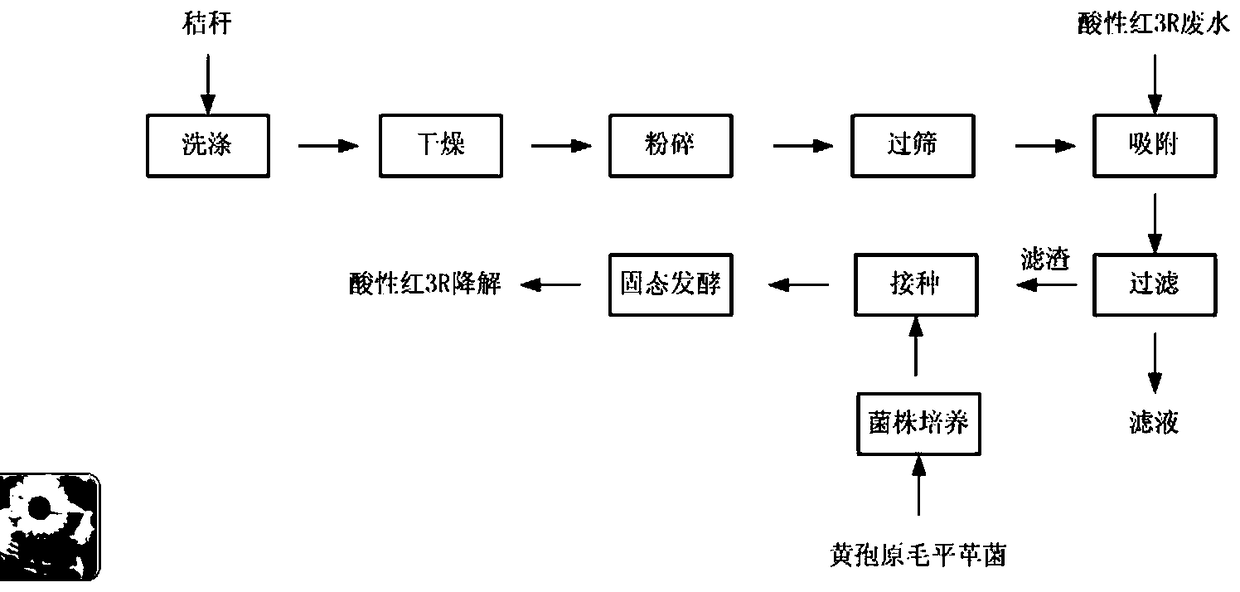A method for removing acid red 3r by straw adsorption coupled with fungal fermentation
A technology of acid red and straw, applied in the direction of microorganism-based methods, fungi, chemical instruments and methods, etc., can solve the problems of water pollution, toxicity, and reduce water transparency, etc., achieve low cost, easy operation, and eliminate harmful pollution Effect
- Summary
- Abstract
- Description
- Claims
- Application Information
AI Technical Summary
Problems solved by technology
Method used
Image
Examples
Embodiment 1
[0022] 1. Pretreatment of straws: straws (rice straws, wheat straws and corn straws) are washed, dried and crushed, and passed through a 40-mesh sieve to obtain straw powder.
[0023] 2. Adsorption of dyes: Weigh 10.0 g of straw powder respectively, according to the solid-liquid ratio of 1:500 ( m / v , g / mL) was added to the wastewater solution with acid red 3R concentration of 100 mg / L, pH 3.5, and NaCl concentration of 1.5 mol / L, at a temperature of 30 °C, a stirring speed of 150 r / min, and an adsorption time of 4 h. The adsorption capacities of rice straw, wheat straw and corn straw were 30.2 mg / g, 39.7 mg / g and 34.6 mg / g, respectively.
[0024] 3. Cultivation of Phanerochaete chrysosporium: At 30°C, cultivate Phanerochaete chrysosporium on a potato dextrose agar plate for 7 days, then use a puncher with a diameter of 1.0 cm to punch holes on the agar plate to obtain a diameter of 1.0 cm. bacteria flakes.
[0025] 4. Solid-state fermentation: filter the above adsorption s...
Embodiment 2
[0027] 1. Pretreatment of straws: straws (rice straws, wheat straws and corn straws) are washed, dried and crushed, and passed through a 40-mesh sieve to obtain straw powder.
[0028] 2. Adsorbed dyes: Weigh 20.0 g of straw powder respectively, according to the solid-liquid ratio of 1:150 ( m / v , g / mL) was added to the wastewater solution with acid red 3R concentration of 200 mg / L, pH 6.0, and NaCl concentration of 0 mol / L, at a temperature of 50 °C, a stirring speed of 200 r / min, and an adsorption time of 6 h. The adsorption capacities of rice straw, wheat straw and corn straw were 19.2 mg / g, 23.3 mg / g and 24.0 mg / g, respectively.
[0029] 3. Cultivation of Phanerochaete chrysosporium: At 30°C, cultivate Phanerochaete chrysosporium on a potato dextrose agar plate for 7 days, then use a puncher with a diameter of 1.0 cm to punch holes on the agar plate to obtain a diameter of 1.0 cm. bacteria flakes.
[0030] 4. Solid-state fermentation: filter the above adsorption solution...
Embodiment 3
[0032] 1. Pretreatment of straws: straws (rice straws, wheat straws and corn straws) are dried and crushed and passed through a 40-mesh sieve to obtain straw powder.
[0033] 2. Dye adsorption: Weigh 20.0 g of straw powder respectively, according to the solid-liquid ratio of 1:300 ( m / v , g / mL) was added to the wastewater solution with acid red 3R concentration of 200 mg / L, pH 4.0, and NaCl concentration of 1.0 mol / L, at a temperature of 40 °C, a stirring speed of 200 r / min, and an adsorption time of 5 h. The adsorption capacities of rice straw, wheat straw and corn straw were 31.8 mg / g, 40.5 mg / g and 39.4 mg / g, respectively.
[0034] 3. Cultivation of Phanerochaete chrysosporium: At 30°C, cultivate Phanerochaete chrysosporium on a potato dextrose agar plate for 7 days, then use a puncher with a diameter of 1.0 cm to punch holes on the agar plate to obtain a diameter of 1.0 cm. bacteria flakes.
[0035] 4. Solid-state fermentation: filter the above adsorption solution to ob...
PUM
| Property | Measurement | Unit |
|---|---|---|
| concentration | aaaaa | aaaaa |
| adsorption capacity | aaaaa | aaaaa |
| adsorption capacity | aaaaa | aaaaa |
Abstract
Description
Claims
Application Information
 Login to View More
Login to View More - R&D
- Intellectual Property
- Life Sciences
- Materials
- Tech Scout
- Unparalleled Data Quality
- Higher Quality Content
- 60% Fewer Hallucinations
Browse by: Latest US Patents, China's latest patents, Technical Efficacy Thesaurus, Application Domain, Technology Topic, Popular Technical Reports.
© 2025 PatSnap. All rights reserved.Legal|Privacy policy|Modern Slavery Act Transparency Statement|Sitemap|About US| Contact US: help@patsnap.com

